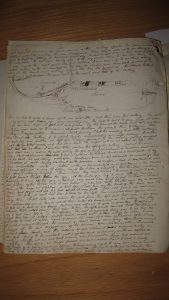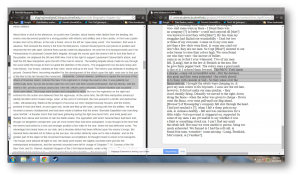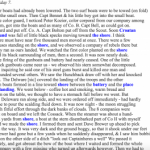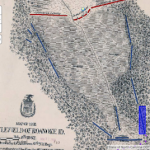Access Course website here.
In the Fall of 2014 student’s in Jakacki’s “Digging into Digital” were introduced to and worked with a cross-section of DH methods (text analysis, encoding, spatial analysis) through engagement with and curation of primary archival materials.  We used as our corpus a sub-section of a diary kept by James Merrill Lynn, a member of Bucknell’s first graduating class while he fought in the 51st Pennsylvania Regiment in Ambrose Burnside’s Civil War expedition to North Carolina. Because the diaries are housed in Bucknell’s special collections, students were able to consider the distinctions between material and digital artifacts as they worked through the text.
We used as our corpus a sub-section of a diary kept by James Merrill Lynn, a member of Bucknell’s first graduating class while he fought in the 51st Pennsylvania Regiment in Ambrose Burnside’s Civil War expedition to North Carolina. Because the diaries are housed in Bucknell’s special collections, students were able to consider the distinctions between material and digital artifacts as they worked through the text.
 We used as our corpus a sub-section of a diary kept by James Merrill Lynn, a member of Bucknell’s first graduating class while he fought in the 51st Pennsylvania Regiment in Ambrose Burnside’s Civil War expedition to North Carolina. Because the diaries are housed in Bucknell’s special collections, students were able to consider the distinctions between material and digital artifacts as they worked through the text.
We used as our corpus a sub-section of a diary kept by James Merrill Lynn, a member of Bucknell’s first graduating class while he fought in the 51st Pennsylvania Regiment in Ambrose Burnside’s Civil War expedition to North Carolina. Because the diaries are housed in Bucknell’s special collections, students were able to consider the distinctions between material and digital artifacts as they worked through the text.For their final individual projects, students had to use two methods they had learned over the course of the semester to answer a research question that they posed about our subject.
 Dale Hartman asked: was Linn a reliable, factual storyteller in the entries in his diary? He pursued his question by doing a side-by-side analysis of Linn’s descriptions of his experiences with a published 19th century biography of General Ambrose Burnside, and then composing a story map that traced Linn’s descriptions alongs the movements of Burnside in the same period.
Dale Hartman asked: was Linn a reliable, factual storyteller in the entries in his diary? He pursued his question by doing a side-by-side analysis of Linn’s descriptions of his experiences with a published 19th century biography of General Ambrose Burnside, and then composing a story map that traced Linn’s descriptions alongs the movements of Burnside in the same period.Connor O’Hara’s queried whetherLinn’s account of his own role in the Battle of Roanokewas as central to the Union success in battle as he described. Through close reading of Linn’s description of topological features of the island that he observed throughout his movement during the battle and comparison with historical maps indicating troop locations of the Union and Confederate regiments, O’Hara concluded that Linn actually was in the thick of the battle at crucial moments.
Sam Loomis was fascinated by Linn’s description of his first experience on a ship traveling from Norfolk, Virginia through the inlet to Cape  Hatteras. In particular, he wondered whether Linn’s observations about the foundering of specific ships after a catastrophic storm could be traced using contemporary nautical maps used by pilots in Pamlico Sound. Through his close reading of both the diary, contemporary accounts of the storm, and a set of maps from 1861-1863, Loomis was able to pinpoint the locations of the ships he identified.
Hatteras. In particular, he wondered whether Linn’s observations about the foundering of specific ships after a catastrophic storm could be traced using contemporary nautical maps used by pilots in Pamlico Sound. Through his close reading of both the diary, contemporary accounts of the storm, and a set of maps from 1861-1863, Loomis was able to pinpoint the locations of the ships he identified.
 Hatteras. In particular, he wondered whether Linn’s observations about the foundering of specific ships after a catastrophic storm could be traced using contemporary nautical maps used by pilots in Pamlico Sound. Through his close reading of both the diary, contemporary accounts of the storm, and a set of maps from 1861-1863, Loomis was able to pinpoint the locations of the ships he identified.
Hatteras. In particular, he wondered whether Linn’s observations about the foundering of specific ships after a catastrophic storm could be traced using contemporary nautical maps used by pilots in Pamlico Sound. Through his close reading of both the diary, contemporary accounts of the storm, and a set of maps from 1861-1863, Loomis was able to pinpoint the locations of the ships he identified.
